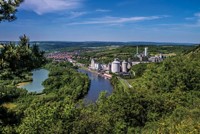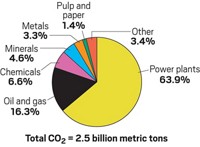Advertisement
Grab your lab coat. Let's get started
Welcome!
Welcome!
Create an account below to get 6 C&EN articles per month, receive newsletters and more - all free.
It seems this is your first time logging in online. Please enter the following information to continue.
As an ACS member you automatically get access to this site. All we need is few more details to create your reading experience.
Not you? Sign in with a different account.
Not you? Sign in with a different account.
ERROR 1
ERROR 1
ERROR 2
ERROR 2
ERROR 2
ERROR 2
ERROR 2
Password and Confirm password must match.
If you have an ACS member number, please enter it here so we can link this account to your membership. (optional)
ERROR 2
ACS values your privacy. By submitting your information, you are gaining access to C&EN and subscribing to our weekly newsletter. We use the information you provide to make your reading experience better, and we will never sell your data to third party members.
Greenhouse Gases
BASF and Air Liquide win EU funding for carbon-capture project
Firms get slice of $1.2 billion in government grants for 7 large decarbonization efforts
by Craig Bettenhausen
November 24, 2021
| A version of this story appeared in
Volume 99, Issue 43

The European Union’s Innovation Fund will put a total of more than $1.2 billion into seven decarbonization efforts across the continent, including a carbon-capture-and-sequestration (CCS) project at BASF’s chemical complex in Antwerp, Belgium. That project, dubbed Kairos@C, will install partner company Air Liquide’s Cryocap cryogenic carbon-capture technology, as well as infrastructure to pump the carbon dioxide into permanent undersea storage.
Over 10 years starting in 2025, the firms say, they will sequester 14.2 million metric tons of CO2 beneath the North Sea.
Though not as common today as systems that catch CO2 in amine solvents, cryogenic carbon capture is an up-and-coming technology. The Cryocap platform planned for the Antwerp complex is already in use at Air Liquide’s hydrogen plant in Port-Jérôme-sur-Seine, France, where the firm says it has been making low-carbon H2 since 2015.
The BASF–Air Liquide project will lower the activation barrier for more CCS by chemical firms and other heavy industry, says David Morrow, a carbon-capture-and-removal policy expert at American University. Each installation reduces risk for the fast-growing CCS industry, making the next project easier to finance. And in Antwerp, other chemical firms with plants nearby—including Solvay, Eurochem, and Ineos—could pipe their own captured CO2 into the same infrastructure.
Of the seven decarbonization projects funded in this first round of grants from the EU, four involve CCS, notes Guloren Turan, advocacy manager for the nonprofit wing of the Global CCS Institute. The other projects focus on green steel, converting municipal solid waste to methanol, and scaling up a new type of solar cell. A second round of grants is now open for applications.
“CCS is essential to the decarbonisation of hard-to-abate sectors like cement and chemicals,” Turan says in an email. “We anticipate CCS networks—multiple capture points with shared transport and storage infrastructure—will continue to emerge and provide economies of scale.”




Join the conversation
Contact the reporter
Submit a Letter to the Editor for publication
Engage with us on Twitter